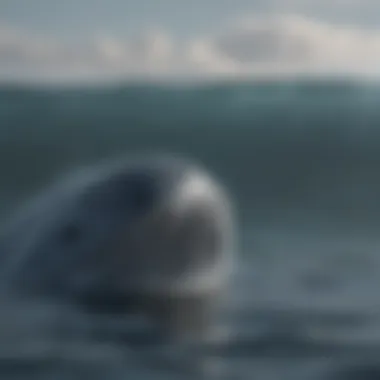Unveiling the Extraordinary Adaptations of Blue Whales in the Oceanic Realm


Nature Topic Overview
Blue whales, the largest creatures on Earth, captivate the imagination with their incredible adaptations for survival in the vast oceans. From their sheer size to their unique feeding methods, these majestic marine mammals are a testament to evolutionary marvels that distinguish them as the giants of the sea.
Fun Facts and Trivia
Did you know that a blue whale's heart is as large as a car and beats only 5 to 10 times per minute? These gentle giants consume millions of krill every day through a specialized feeding system that includes baleen plates in their mouths. Dive into the world of blue whales to uncover more fascinating facts like these!
Wildlife Explorations
Explore the blue whale's habitat alongside other fascinating ocean species. Learn about the interconnected nature of marine ecosystems and the importance of preserving biodiversity. Engage in quizzes and puzzles designed to deepen your understanding of these magnificent creatures and their environment.
Environmental Awareness
Understanding the significance of conservation efforts is crucial in protecting blue whales and their habitat. Discover how simple actions like reducing plastic use and supporting sustainable practices can make a difference in safeguarding these magnificent marine species for future generations. Dive into a world where every individual can contribute to preserving the beauty of our oceans.
DIY Nature Activities
Get hands-on with nature-inspired activities that bring you closer to the world of blue whales. From creating ocean-inspired crafts to embarking on outdoor explorations that mirror the ways of these magnificent beings, there are endless possibilities for young minds to connect with nature and learn about the precious balance of marine life.
Introduction
Blue whales, the majestic giants of the ocean, embody a marvel of evolution that captivates the minds of marine enthusiasts worldwide. In this comprehensive exploration of blue whale adaptations, we delve into the intricate mechanisms that enable these creatures to thrive in the expansive depths of the sea. From their sheer size to their unique feeding behaviors, blue whales stand as a testament to nature's unparalleled creativity and efficiency. This article serves as a guide to unraveling the mysteries behind the adaptations that have propelled blue whales to claim the title of Earth's largest animals.
As we embark on this journey of discovery, we will dissect the various facets of blue whale adaptations, shedding light on how each characteristic contributes to their survival in the vast oceans. By exploring the nuances of their physical features, feeding strategies, migration patterns, communication techniques, and behavioral traits, we aim to provide a holistic understanding of these marine marvels. Through a blend of scientific insight and captivating storytelling, we invite readers to marvel at the wonders of nature and gain a newfound appreciation for the intricate web of life beneath the ocean's surface.
To fully grasp the significance of blue whale adaptations, we must first recognize the immense biological complexity that underpins every aspect of their existence. From the unparalleled efficiency of their feeding mechanisms to the strategic brilliance of their migratory behaviors, blue whales navigate the challenges of the marine environment with remarkable skill and precision. By unraveling the secrets of their adaptations, we not only gain insight into the evolutionary forces that have shaped these majestic creatures but also appreciate the delicate balance that sustains life in the world's oceans.
Join us as we embark on a voyage of discovery through the realm of blue whale adaptations, where every flip of a flipper and every resonant song carries a story of resilience, innovation, and survival against the backdrop of the vast and enigmatic ocean.


Physical Adaptations
Blue whales exhibit remarkable physical adaptations that enable them to thrive in the vast oceans. These adaptations play a crucial role in their survival, with each aspect finely tuned for their marine lifestyle.
Size and Body Structure
Blue whales are known for being the largest animals on Earth, a title that showcases their impressive physical adaptation. Their colossal size allows them to navigate the ocean depths while maintaining a strong presence as apex predators. This feature of being the largest animal on Earth is significant in highlighting the evolutionary uniqueness of blue whales, setting them apart from all other species. Despite their massive size, blue whales have managed to optimize their body structure for streamlined movement in the water, showing how this adaptation is a beneficial choice for their survival in the marine environment.
Blubber Layer
The blubber layer of blue whales serves multiple crucial functions, primarily providing insulation and serving as an energy reserve. This layer of fat beneath their skin helps in retaining body heat, essential for sustaining their core temperature in cold ocean waters. Additionally, the blubber acts as an energy store, enabling blue whales to survive extended periods without food. The strategic presence of this blubber layer showcases the adaptation's advantage in maintaining the whale's bodily functions and overall health in challenging marine conditions.
Flippers and Tail
Blue whales possess unique flippers and a powerful tail that are essential for efficient propulsion and maneuverability in the water. The distinct shape and size of their flippers aid in navigation and steering, allowing for precise movements while swimming. Paired with their massive tail, these adaptations contribute to the blue whale's exceptional speed and agility in capturing prey and avoiding potential threats. The combination of flippers and tail proves to be a valuable adaptation for blue whales, enhancing their hunting capabilities and overall survival potential in their aquatic habitat.
Feeding Adaptations
Filter-Feeding Mechanism
The filter-feeding mechanism is a remarkable adaptation that sets blue whales apart in the realm of marine mammals. One integral component of this mechanism is the employment of baleen plates. These baleen plates act as a filter, capturing krill while allowing water to pass through. The intricate design of baleen plates facilitates the consumption of large quantities of krill with each gulp, maximizing the efficiency of the feeding process. This adaptation is crucial for the sustenance of blue whales, as krill serves as their primary source of nutrition in the oceanic environment.
Baleen Plates and Krill Consumption
The utilization of baleen plates by blue whales showcases a sophisticated evolutionary strategy for efficient krill consumption. Baleen plates are composed of keratin, a durable protein found in various animal structures, providing strength and flexibility to the filtering apparatus. This unique biological feature enables blue whales to filter out krill while expelling excess water, optimizing their feeding efficiency. The adaptation of baleen plates in krill consumption reflects the evolutionary success of blue whales in adapting to their environment and thriving as the largest animals on Earth.
A monumental advantage of baleen plates in krill consumption lies in their ability to trap small krill while allowing larger prey to escape, ensuring blue whales can target their preferred food source effectively. However, a potential disadvantage of this mechanism is the reliance on consistent krill populations, making blue whales susceptible to fluctuations in krill availability due to environmental changes.
Gulping Technique


Another essential aspect of blue whales' feeding adaptations is the gulping technique they employ to filter food effectively. The gulping technique involves swallowing vast amounts of water containing krill, subsequently using their baleen plates to filter out the krill from the ingested water. This technique allows blue whales to target concentrated patches of krill efficiently, maximizing their feeding intake in a single maneuver.
Swallowing Vast Amounts of Water to Filter Food
Swallowing vast amounts of water to filter food is a specialized behavior that highlights the adaptability of blue whales in optimizing their feeding process. This technique enables blue whales to capitalize on their immense size and engulf significant quantities of krill-laden water in a single gulp, a crucial strategy for meeting their energy requirements. The unique feature of this gulping technique lies in its efficiency in extracting krill from the water column, ensuring blue whales can acquire sufficient nutrition to support their metabolic demands.
While the gulping technique offers blue whales a competitive edge in capturing krill efficiently, it also poses potential challenges, such as increased energy expenditure during the filtration process. Despite this, the gulping technique remains a vital component of blue whales' feeding adaptations, underscoring their remarkable capacity to thrive in their marine habitat.
Migration Patterns
Seasonal Travel Routes
Long-Distance Movements for Breeding and Feeding
The unique aspect of Long-Distance Movements for Breeding and Feeding defines the evolutionary strategy of blue whales in their pursuit of sustenance and reproduction. These extensive travels form a crucial part of the blue whale life cycle, ensuring access to nutrient-rich feeding grounds and facilitating mating opportunities. The key characteristic of Long-Distance Movements lies in the endurance and persistence exhibited by blue whales as they journey across oceans, showcasing their remarkable adaptation for survival in challenging marine environments. The benefits of this strategy are manifold, enabling blue whales to secure necessary resources while fostering genetic diversity through widespread breeding efforts. Despite the challenges posed by long-distance travel, blue whales have optimized this approach to sustain their populations and ensure species resilience in ever-changing oceanic conditions.
Environmental Cues
Navigating Oceans Using Natural Signals is a fundamental aspect of blue whale behavior, guiding their movements and interactions within aquatic ecosystems. Blue whales rely on environmental cues such as water temperature, salinity levels, and magnetic fields to inform their migratory routes and foraging areas. The key characteristic of such navigation is the innate ability of blue whales to interpret subtle environmental variations and adapt their behavior accordingly, demonstrating a sophisticated understanding of marine systems. This reliance on natural signals enhances the survival prospects of blue whales, allowing them to capitalize on optimal conditions for feeding and reproductive activities. While advantageous in optimizing resource utilization, the dependence on environmental cues also exposes blue whales to potential disruptions caused by human-induced changes in oceanic habitats, highlighting the vulnerabilities inherent in their adaptation strategies.
Communication Adaptations
Communication adaptations play a crucial role in the survival and success of blue whales in their oceanic habitat. These adaptations involve intricate systems of sounds and vocalizations that serve various purposes essential for their mating rituals and social interactions. Blue whales use complex sounds to convey emotions, locate suitable partners for mating, and establish social hierarchies within their pods. By emitting specific vocalizations, blue whales can communicate over vast distances in the vast expanse of the ocean, ensuring effective coordination and interaction among individuals. This section explores how these communication adaptations have evolved to meet the specific needs of blue whales, facilitating their thriving existence.
Songs and Vocalizations
Complex Sounds for Mating and Social Interactions
The complex sounds produced by blue whales are integral to their mating and social interactions. These sounds consist of a diverse range of frequencies and patterns that carry detailed information important for reproductive success and social bonding. Blue whales often utilize these complex sounds during the mating season to attract potential mates and establish dominance among rivals. The unique feature of these vocalizations lies in their ability to convey intricate messages that enhance breeding opportunities and strengthen social bonds within their pod.


In the context of this article, the focus on complex sounds for mating and social interactions sheds light on how blue whales' communication strategies are honed to ensure successful reproduction and cohesive social structures. By delving into the nuances of these sounds and their significance in the underwater realm, readers can appreciate the sophisticated nature of blue whale communication and its vital role in sustaining their populations.
Echo Location
Navigating and Locating Prey in Deep Waters
Echo location is a vital adaptation employed by blue whales to navigate the expansive ocean depths and locate prey efficiently. By emitting high-frequency sounds that bounce off objects in their surroundings, blue whales can create a mental map of their environment, helping them detect food sources and potential obstacles with remarkable accuracy. This echolocation ability empowers blue whales to forage effectively in dark, murky waters where visibility is limited, enabling them to fulfill their nutritional requirements amid challenging conditions.
The key characteristic of this echolocation mechanism is its precision in identifying and tracking prey in vast and dynamic underwater landscapes. By harnessing the unique feature of echolocation, blue whales optimize their hunting strategies, ensuring successful feeding while reducing the energy expended in the search for food. This article highlights how echolocation enhances the foraging prowess of blue whales and underscores its crucial role in their survival within the intricate marine ecosystems.
Behavioral Adaptations
Adaptations in behavior play a crucial role in the survival and success of blue whales. Understanding the behavioral patterns of these majestic creatures provides insights into their social interactions and their ability to navigate vast ocean environments effectively. By observing blue whales' behavioral adaptations, researchers can unravel the intricacies of their communication methods, mating rituals, and strategies for hunting and evading predators. Studying behavioral adaptations offers a window into the evolutionary dynamics that have shaped blue whales into the remarkable creatures they are today.
Social Structures
Blue whales exhibit complex social structures centered around pod dynamics and family units. These social groups are essential for their survival, providing support, protection, and opportunities for cooperative behaviors such as hunting and raising offspring. Pod dynamics involve intricate levels of communication and hierarchy within a group, ensuring efficient decision-making and shared responsibilities among members. Family units maintain cohesion and ensure the passing down of knowledge and traditions from one generation to the next, creating a sense of continuity and unity within the social fabric of blue whale communities.
Pod Dynamics and Family Units
The pod dynamics of blue whales entail sophisticated social interactions that contribute to the overall well-being of the group. Cooperation within the pod allows for effective communication during travel, hunting, and breeding activities. The key characteristic of pod dynamics lies in the collaborative efforts that optimize the pod's collective resources and skills. This cooperative structure benefits the pod by fostering strong bonds, enhancing survival rates, and promoting efficient utilization of food resources. The unique feature of family units in blue whale pods lies in the presence of maternal care and intergenerational knowledge transfer, ensuring the growth and development of younger members while maintaining the cultural heritage of the group.
Diving Abilities
Blue whales' diving abilities are finely tuned for deep dives that facilitate feeding and evasion of predators. Their remarkable capacity to descend to great depths enables them to access nutritious prey sources in the ocean's depths while minimizing the risks posed by potential threats. By engaging in deep dives, blue whales can exploit food-rich zones that are beyond the reach of shallower-diving competitors, giving them a competitive edge in resource acquisition. The unique feature of deep dives lies in the physiological adaptations that enable blue whales to withstand immense water pressure and oxygen deprivation, showcasing their evolutionary specialization for survival in challenging marine environments.
Conclusion
Nestled within the nuances of each subsection, from the sheer size and body structure to the intricate communication networks they employ, lies a tapestry of evolutionary ingenuity that illuminates the essence of their existence in the vast oceans. The conclusion, therefore, acts as a cognitive bridge that connects the intricate puzzle pieces of blue whale adaptations, allowing us to marvel at the sheer complexity and brilliance of nature's design.
Delving deeper into the significance of the conclusion within this article, it becomes evident that the synthesis of varied adaptations not only elucidates the sheer magnitude of blue whale evolution but also underscores the intrinsic connections between form and function. By unraveling the layers of their feeding mechanisms, migratory patterns, communication strategies, and behavioral intricacies, we unearth a profound appreciation for the finely tuned adaptations that equip blue whales to navigate the oceanic expanse with unparalleled grace and efficiency.
Moreover, the conclusion serves as a beacon of insight into the depths of scientific inquiry, beckoning us to contemplate the broader implications of understanding and preserving these magnificent creatures. As we traverse through the rich tapestry of blue whale adaptations, it becomes clear that each facet contributes to their holistic existence, emphasizing the delicate balance between environmental factors and evolutionary imperatives.
In essence, the conclusion encapsulates not just the culmination of a detailed exploration into blue whale adaptations but also propels us towards a deeper understanding of our interconnectedness with the natural world. Through the lens of these colossal marine giants, we are afforded a glimpse into the intricacies of adaptation, resilience, and coexistence, shaping a narrative that transcends mere scientific discourse to evoke a profound sense of wonder and reverence for the world around us.







